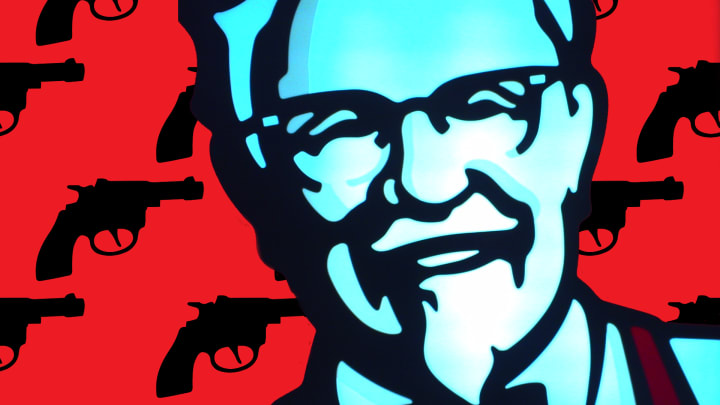Fast Feud: When Colonel Sanders Shot a Rival Gas Station Owner
On May 7, 1931, Matt Stewart was busy painting over a sign on a cement wall in Corbin, Kentucky, when a car pulled up. Three men were inside.
“Well, you yellow dog, I see you are smearing that sign again,” one of them snarled.
Stewart probably didn’t have to turn around to know who had spoken. It was his nemesis: Harland Sanders. Guns were pulled, shots were fired, and by the end of the altercation, one man would be left dead.
Whose Sign Is It Anyway?
At the time of the shootout, Harland Sanders was still years away from founding Kentucky Fried Chicken (now technically just KFC) and becoming an honorary colonel. But he had already leaned hard into the enterprising spirit that would help him build a fast food empire from the ground up. At the early end of the Great Depression, he started running a Shell gas station in Corbin and soon began publicizing it on the sides of barns around town.
Sure, he could have stuck to billboards, but those were a favorite target among Corbin’s many trigger-happy locals. In fact, gun action was so rampant in North Corbin that people called it “Hell’s Half-Acre.” They’d think twice about shooting at a barn, however, since bullets could easily harm whatever livestock was inside. When Sanders spotted a concrete wall on U.S. Route 25 just half a mile or so south of his station, he turned that into ad space, too. His sign comprised a giant arrow bearing the phrase “North to Lexington,” a clear message that gas was ahead.
But directing drivers toward Sanders’s stop also meant steering them away from Matt Stewart’s nearby Standard Oil station. So, on the grounds that the sign sat on land owned by a railroad company, Stewart painted over it—using a tough-to-remove, tar-like substance called creosote. Sanders undid the damage and promptly confronted Stewart. The meeting didn’t go well; according to The Colonel, John Ed Pearce’s biography of Sanders, one or both of the men threatened to “blow your goddam head off.”
So tensions were already running high when, early on May 7, a kid showed up at the Shell station and told Sanders that Stewart was once again obliterating his arrow.
Stewart’s Last Stand
Sanders opted for another confrontation—and this time, he wasn’t alone. Shell district manager Robert Gibson and Shell supervisor Carlyle Shelbourne (variously spelled “Carlile” and “Shelburne”) happened to be visiting the station that morning and agreed to accompany him.
Accounts differ on the exact progression of the chaos that ensued after the group surprised Stewart on his ladder, though Gibson seems to have exited the car and approached Stewart before his companions did. While it’s unclear who drew their gun or fired first, Stewart claimed it was his opponent. When Gibson’s pistol failed to go off, then, Stewart had time to defend himself.
And defend himself he did. He fired several shots straight at Gibson, who crumpled almost immediately. Shelbourne then allegedly whipped out his own gun while Sanders seized Gibson’s (or drew his own, if you prefer Stewart’s version of events), and the two managed to hit Stewart twice.
The blows succeeded in halting Stewart’s attack, but weren’t severe enough to kill him. Gibson wasn’t as lucky: He breathed his last before even making it to the hospital. This was bad luck for Stewart, too, who now faced a murder charge. After recovering from his wounds and eventually standing trial in October 1932, the station owner was convicted and sentenced to 18 years in prison.
His hapless streak was far from over. In July 1933, while Stewart was out of prison awaiting an appeal, he was shot and killed by a deputy sheriff who had come to arrest one of Stewart’s employees. The details of the scuffle were murky, and a rumor even circulated that Gibson’s relatives had commissioned the deputy sheriff to put the hit on Stewart.
Blood Is Thicker Than Water—But Chicken Is Thicker Than Blood
As for the future king of KFC: The shootout hardly even left a stain on his résumé (which could partially be due to the fact that newspapers identified him as “H.D. Saunders” or “H.C. Saunders” in reports of the incident). The charges against him and Shelbourne were dropped, and Sanders returned to his Shell station, where he soon established his first eatery.
His entanglement with the Stewart family didn’t end there, though. Stewart’s daughter, Ona May, married a brother of Claudia Price, who would become Sanders’s second wife in 1949. Price had started out waitressing for Sanders and eventually graduated to managing his second Sanders Court—a restaurant and motel—in Asheville, North Carolina.
Ona May would follow a similar trajectory: Sanders hired her as a waitress and later entrusted her with the management of his original Sanders Court in Corbin during and after World War II. She left briefly to run her own restaurant downtown, but soon returned to the Colonel’s orbit to co-own one of his spots in Lexington, Kentucky.
“I always knew I could count on him,” she said, according to Pearce’s The Colonel. After all, he had always been a real straight shooter.
